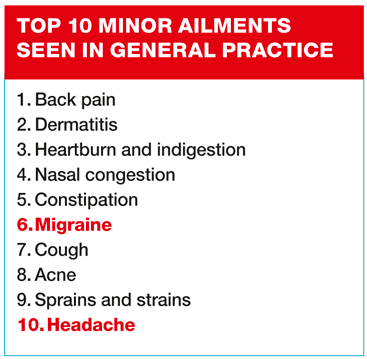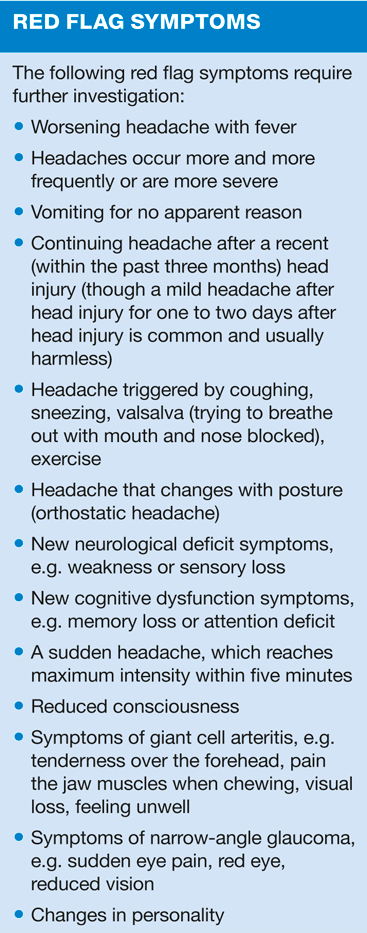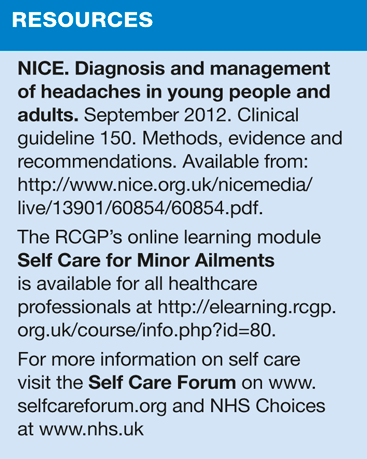Headache and migraine in young people and adults
Dr Knut Schroeder
Dr Knut Schroeder
FRCGPGP
Concord Medical Centre, Bristol, and Honorary Senior Clinical Lecturer in Primary Health Care, University of Bristol Self Care Forum Board member and author of 'Diagnosing Your Health Symptoms For Dummies' &
Sara Richards
RN
Specialist Primary Care Nurse, Practice Nurse Facilitator, Berkshire Self Care Forum Board member
Together headache and migraine are the reason for 4.5 million primary care consultations each year, at a cost of £63.6m. This latest in a series self care articles incorporates new NICE guidance on this important symptom
WHAT IS HEADACHE?
Common primary headaches include tension-type headache, migraine and cluster headache - conditions for which the underlying causes are still poorly understood. Disorders such as medication overuse, giant cell arteritis, or raised intra-cranial pressure (for example, from a haemorrhage or tumour) cause secondary headaches. Although headaches can reduce quality of life considerably, people with headache alone rarely suffer from a serious underlying cause.
Symptoms vary depending on the headache type:
- Tension-type headache - mild-to-moderate, tightening bilateral pain, with no accompanying symptoms
- Migraine headache - pulsating, moderate-to-severe unilateral or bilateral pain, accompanied by nausea/vomiting and sensitivity to light or sound. Some sufferers also experience aura, with or without headache. Aura symptoms include visual disturbances (flickering lights, spots or partial vision loss), sensory symptoms (numbness, pins and needles) and speech alterations. Migraines can have many triggers (such as certain foods, stress, hunger and fatigue) and may be exacerbated by menstrual changes or the combined oral contraceptive pill
- Cluster headache - extremely severe unilateral pain around or above one eye and along the side of the face, with accompanying red/watery eye, nasal congestion, swollen/dropping eyelid and irritation/restlessness.
HOW COMMON IS IT?
Headache is a common neurological symptom. It is the reason for four out of 100 primary care consultations and around a third of neurology outpatient appointments. Tension-type headache is the most frequently occurring headache, with a lifetime risk of 70-80%. Migraine affects around 15% of adults, while cluster headache occurs in just 1% of the population at some time in their life.
WHAT CAN PATIENTS EXPECT?
Most headaches resolve spontaneously, many of them within 24 hours. Migraines can take up to 72 hours to resolve, while cluster headaches can last for 15-180 minutes and recur up to eight times per day. Patients will not usually require further investigations, such as CT or MRI scanning and blood tests, unless warning symptoms are present (see Box).
WHAT CAN PEOPLE DO TO HELP THEMSELVES?
Using a headache diary to record the frequency, duration and severity of headaches can help with identifying triggers (in the case of migraine) and monitoring the effectiveness of headache interventions. Such a diary can also be helpful when discussing headaches with a health professional. Advise people to get plenty of rest and relaxation, and to avoid dehydration, too much alcohol and skipping meals. Getting enough sleep is also important. Acupuncture can help with preventing chronic tension-type headache and migraine attacks.
WHICH OTC PREPARATIONS CAN PEOPLE USE?
Aspirin, paracetamol or a non-steroidal anti-inflammatory drug (NSAID), such as ibuprofen, can be helpful for treating acute tension-type headache. The choice of preparation should take into account personal preferences, any other medical conditions and the risk of potential adverse effects. Aspirin or NSAIDs should be taken with or after food and avoided in those with existing, or history of, serious gastrointestinal complaints or aspirin-sensitive asthma. Opioids, such as preparations containing codeine, should be avoided in the treatment of acute tension-type headache.
Combination therapy with an oral triptan (sumatriptan is available OTC), an NSAID or paracetamol can be helpful for the treatment of acute migraine. If monotherapy is preferred, advise either sumatriptan, aspirin (900mg), other NSAIDs or paracetamol. An anti-emetic may help with relieving nausea and vomiting. Opioids are also not recommended for treating acute migraine. Cluster headaches should not be treated with OTC medication.
Advise all headache patients about the risk of medication overuse headache, a chronic headache that can develop in those using paracetamol, aspirin or NSAIDs on 15 or more days per month, or opioids for 10 or more days per month.
WHEN SHOULD PATIENTS RETURN?
People should seek medical advice if they have any of the red flag symptoms (see Box), feel unwell between their headaches, their symptoms are not relieved by OTC treatments, or their headaches are so severe that they find it difficult to get on with their daily activities or go to work. All children with persistent headache should be referred to their GP for investigation.
WHAT ARE THE NEXT STEPS?
Most headaches only require clinical assessment if the diagnosis is unclear or needs to be confirmed, and most patients can safely be managed in primary care. In the case of frequent migraines, patients should see their doctor to discuss the benefits and risks of prophylactic treatment with drugs such as topiramate or propranolol, taking into consideration the impact that the headache has on the person's quality of life and other factors, such as co-morbidities.
SUMMARY
Headaches are common, mostly harmless, and often respond well to widely available OTC preparations and changes in lifestyle. Symptoms that are not well controlled or affect daily life and the presence of red flags should prompt further medical assessment.
Related articles
View all Articles



